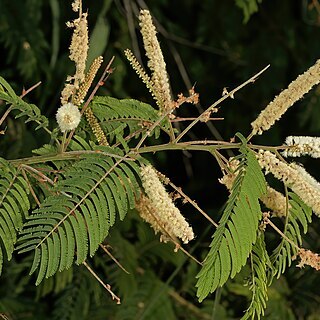Scandent shrub up to 15 m high, often with many stems arising from a common base, a non-climbing shrub or occasionally a tree up to 10 m high, crown often slightly rounded in arborescent forms; trunk to 0.5 m diam. Bark pale to dark yellowish-or grey-brown, rough, slightly fissured, sometimes flaking; young branchlets pale yellowish-or grey-to reddish-brown, sparingly to densely pubescent, indumentum frequently slightly golden. Stipules not spinescent, in pairs above the nodes, obliquely ovate (rarely almost linear), up to 12 x 7 mm, soon deciduous. Prickles scattered along the internodes, usually strongly recurved, reddish-brown to purplish, often broad-based, up to 15 mm long. Leaves: petiole (0.4)1-2(3.4) cm long, adaxial gland usually present (sometimes two), variable in position, usually stalked, up to 2 mm high; rhachis (2.3)6-12(16.5) cm long, sparingly to densely pubescent, rarely subglabrous, with or without recurved prickles abaxially, a gland often present at the junction of the top pair of pinna only or between the top 1-5 and occasionally the lowest 1-3 pairs; pinnae (6)8-20(29) pairs; rhachillae (0.9)2.6-4.2(7.3) cm long; leaflets 19-62 pairs per pinna, 2-6.9 x 0.5-1.3 mm, linear to linear-oblong, often slightly falcate, apex obtuse to acute, margins with or without ciliate hairs, glabrous abaxially or appressed-pubescent with a tendency for an apical and/or basal tuft. Inflorescences spicate, fascicled or crowded into an irregular terminal raceme, occasionally solitary. Flowers yellowish-white, pedicellate or appearing sessile; spikes 2.2-11.5 cm long; peduncles 0.3-2.5 cm long, sparingly to densely pubescent. Calyx cupular, glabrous to sparingly pubescent, usually 1/3-1/2 as long as corolla, tube 0.6-1.7 mm long, lobes 0.2-0.6 mm long. Corolla campanulate, glabrous to sparingly pubescent, tube 1.4-2.2 mm long, lobes up to 0.8 mm long. Stamen-filaments free, up to 6 mm long; anthers 0.15 mm across, with a deciduous apical gland. Ovary densely pubescent, 0.6-1.4 mm long, on a stipe longer than itself. Pods reddish-or purplish-brown, 5.3-20.4 x 0.9-2.4 cm, linear-oblong, straight, very acuminate at both ends or merely acute, longitudinally dehiscent, brittle, umbonate over the seeds, glabrous or subglabrous. Seeds olive-brown, subcircular-lenticular, 6-9 mm in diam., compressed; areole central, small, 2.5-3 mm in diam., obscure.
More
Scandent shrub, climber, 3-15 m high, many stems arising from common base, trunk up to 0.5 m in diam. Bark yellowish or grey-brown, rough, slightly fissured, sometimes flaking. Branches sparingly to densely pubescent when young, slightly golden; prickles scattered along internodes, strongly recurved, reddish brown, up to 15 mm long. Leaves bipinnate, rachis 60-165 mm long, pinnae 8-25 pairs, each with 19-62 pairs leaflets. Flowers in spikes, 22-115 mm long, yellowish white. Flowering time Jan., Feb. Pod reddish or purplish brown, linear-oblong, 200 x 24 mm, straight, acuminate at both ends.
A climber or straggling herb. It is usually thorny. It has several stems. It forms thickets. It can be a small tree to 10 m high. The branches are flexible. It loses its leaves during the year. The leaves have 10-25 pairs of leaf stalks each with 14-62 pairs of leaflets. The leaflets are 2-5 mm long by 0.5-1.5 mm wide. The flowers are creamy white in spikes 10 cm long. The fruit are young pods which are red then turn brown. They are slender and 20 cm long by 2.4 cm wide. They taper at both ends.
Scandent shrub or tree, up to 15 m high, armed with prickles, scattered irregularly along internodes. Flowers in spikes. Pods reddish brown to purplish, usually distinctly acuminate at both ends brittle. Flowers yellowish white.
Can be grown by seedlings. Seeds needs soaking.


